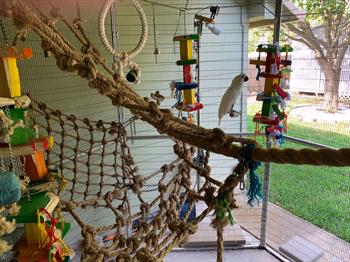Nikolai in his outdoor aviary

Photo courtesy Michael Steele
More than 20 million pet birds live in the United States; birds are adored for their beautiful appearances, extraordinary personalities, and unique behaviors. As we continue to make more progress toward understanding some of the medical and behavioral challenges associated with taking care of birds, one particular area of interest for bird owners is environmental enrichment.
Boredom and the stress associated with the inability to perform natural behaviors are common challenges associated with bringing animals into our homes because they rely heavily on their natural instincts. Our goal for the birds in captivity should be to replicate their natural history and environment as much as possible in captivity to avoid the development of major social, behavioral, and physiological issues. For instance, research indicates that the intelligence of Psittacines is comparable to that of a 3-5 year old human child, so they deserve a similar level of stimulation and socialization throughout their day to day routines to ensure appropriate development and quality of life. Without environmental enrichment, a bird’s boredom may progress to stress and changes in behavior. Some common causes of stress in captive animals include restrictive enclosures, suboptimal nutrition, the reduced or restricted ability to exercise, inadequate habitat, and a lack of mental stimulation.
As with humans, there are often predictable signs and behaviors observed in captive animals that we associate with stress and boredom, and as owners and clinicians, our challenge is to learn to understand these signs within our avian friends so we can intervene whenever they arise.
Some common behaviors that may indicate stress or boredom in pet birds include self-destructive behavior, feather picking, open-beak breathing, fearful or aggressive behaviors, trembling, and excessive vocalization and screaming. If your veterinarian isn't comfortable working with these issues, see an avian specialist. Although experiencing some level of stress or boredom is normal for any species, giving our pets the option to expand their mental, physical, and behavioral repertoire is a great first step to ensuring they maintain a happy, healthy lifestyle.
Environmental enrichment is a means to provide pet birds in captivity with the ability to express natural behavior, such as foraging, exploration, exercise, etc. Some of the most common themes for enrichment that we focus on with pet Psittacines include: providing opportunities to exhibit foraging behavior, investigation of novel items, destroying/manipulating items (like tearing up a phone book or newspaper), social interaction, the opportunity to exercise (climb, fly, etc.), and puzzles to manipulate.
There are many different options when it comes to empowering our pets through enrichment, and a little creativity will serve you well. Some items for enrichment can be bought at a store, but most enrichment can be done through using what you already have at home. Here are a few ideas to get you started, but the sky is the limit when it comes to what you can offer.
- Provide safe items for movement and stimulation (toys, treats, swinging perches).
- Use training and rewards to challenge them mentally (see target training description below).
- Change up their environment (move items in their cage a few times per week, add a new item).
- Provide perches of a variety of shapes/textures/materials and diameters to replicate natural perches and ensure foot health
- Give items to stimulate natural behaviors like foraging, climbing, and perching (hide treats in grass, add items to shred).
- Provide simple items for them to play with (recycled coffee filters, toilet paper tubes, and paper cups).
- Hang treats and fruit from the top of the cage to challenge them physically.
- Use food dispenser toys so the bird has to work for food (ball with holes in it).
- Add safe components of their natural environment (sticks for perching, leaves).
- Provide out of enclosure time with you.
- Make sure they have a proper day/night cycle.
Target training is a technique that can be used to modify behaviors through operant conditioning, which involves the use of positive reinforcement (rewards) to shape desirable behaviors and eliminate undesirable ones. This technique is a great way to challenge these highly intelligent animals to learn new things while also developing a strong social bond with their owners.
While developing these enrichment tools and strategies, it is important to evaluate their safety and potential hazards that could be associated with them. You should always assess and eliminate potential risks of strangulation (neck, legs, extremities), toxicities, ingestion of objects, and injury before implementing enrichment tools and ideas. It is also important to observe your bird using their enrichment tools to ensure that they are safe and able to effectively stimulate your bird.
Just like humans, birds express their emotions through specific signs and behaviors. As we continue to learn to better understand them, we can take steps to improve the mental, physical, and emotional health of our companions through the use of environmental enrichment. Enrichment does not have to be extravagant or expensive. It can be as simple as providing a paper towel roll to push around their enclosure or changing the location of things that are already inside of their living space. Creativity and variety are the keys to success when it comes to keeping our pets stimulated. There are a variety of online resources that you can consult for ideas, including the American Association of Zoo Keepers guidelines to environmental enrichment. Maintaining the health and happiness of our pets is always a top priority as owners, and incorporating environmental enrichment into your bird’s daily routine is a simple and effective way to ensure that their quality of life never stops improving.